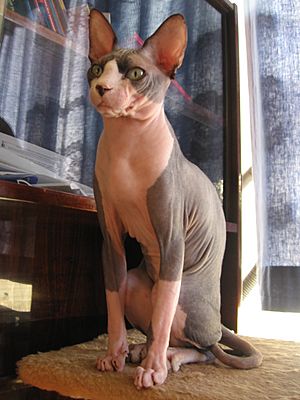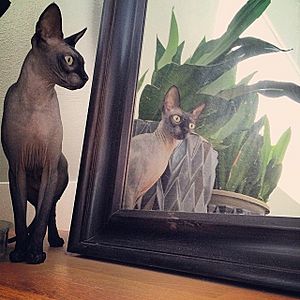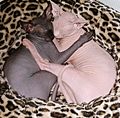Sphynx cat facts for kids
Quick facts for kids Sphynx |
|
|---|---|
 |
|
| Origin | |
| Breed standards | |
| CFA | standard |
| FIFe | standard |
| TICA | standard |
| ACFA/CAA | standard |
| CCA-AFC | standard |
| Domestic cat (Felis catus) | |
The Sphynx is a special breed of cat. It looks like it has no hair, but it's not completely bald! Its skin is very soft because it has a thin layer of fine fuzz, like peach skin. Some Sphynx cats have whiskers, and some don't.
The color and patterns you see on a Sphynx's skin are the same as the fur patterns on other cats. For example, you might see a calico or tabby pattern right on their skin. Because they don't have a thick coat, they lose body heat faster than other cats. This means they feel very warm when you touch them! They also love to find sunny spots or warm places to nap because they get cold easily.
Young kittens of this breed can sometimes get sick with breathing problems during their first few weeks. Good cat breeders make sure kittens stay with their mothers until they are at least 14 weeks old. This helps them grow strong and healthy before moving to a new environment.
History of the Sphynx Cat
The Sphynx was not the first hairless domestic cat ever known. Other hairless cats had been seen around the world for about 90 years before the Sphynx breed started.
The Sphynx breed officially began in 1966. This happened in Toronto, Ontario, Canada. A hairless kitten named Prune was born to a regular black and white shorthair cat. Prune was later bred with his mother, and another hairless kitten was born. These cats, along with a few other hairless kittens found later, helped start the Sphynx breed.
More hairless cats were found naturally on a farm in Minnesota in the mid-1970s. The owners found hairless kittens in several litters of their barn cats. Two hairless female kittens born in 1975 and 1976, named Epidermis and Dermis, were very important. They helped grow the new breed. Other hairless cats were also found in Texas and Arkansas. So, the modern Sphynx breed comes from both the Canadian cats and the Minnesota cats.
The first people who bred these cats faced some challenges. They didn't know much about cat genetics at first. The group of cats they had to breed from was small, which caused some health problems. Many kittens did not survive, and some of the adult female cats had health issues.
Sphynx Cat Behavior
Sphynx cats are known for being very friendly and not shy at all. They have a lot of energy and are very smart. They are also very curious and love their owners a lot.
Many people say Sphynx cats act more like dogs than cats. They often run to the door to greet their owners when they come home. They are also very welcoming and friendly when they meet new people.
Caring for a Sphynx Cat
Even though Sphynx cats don't have fur to brush, they still need special care. They need a bath about once a week. This helps wash off the natural oils that build up on their skin.
Sphynx cats should always be kept indoors. First, their skin can easily get a sunburn if they spend too much time in the sun. Second, they can't stay warm outside, especially in cold weather. Because of this, some owners dress their Sphynx cats in warm clothes during the winter months.
See also
 In Spanish: Sphynx para niños
In Spanish: Sphynx para niños








